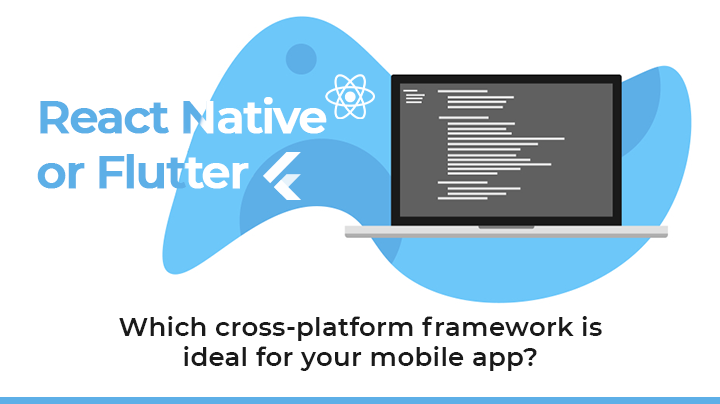React Native or Flutter, which cross-platform framework is ideal for your mobile app?

When it comes to choosing the best framework for cross-platform web & mobile app development, the debate on React Native VS Flutter never concluded from years to years. The immense popularity of both the frameworks for building native apps inspires modern programmers to leverage them for some major reasons.
Whether one is a beginner or an experienced developer, it is dilemmatic to choose between React Native and Flutter. In this article, we will get you a brief on both the frameworks along with their comparative analysis to pick an ideal cross-platform framework for your next project.
A quick intro to React Native & Flutter
All about React Native framework
In 2015, Facebook launched to React Native as an open-source mobile app framework for developing cross-platform apps. Modern developers choose to React Native to build high-performing mobile and web apps with robust features & native platform capabilities. Being one of the most preferred cross-platform frameworks, React Native is a building block for many popular apps such as Facebook, Instagram, Tesla, Skype, Bloomberg, Pinterest, & more for iOS, Android, web, & UWP platforms.
React native developers create multi-functional mobile & web apps for universal platforms with stunning user interfaces by leveraging a single code base. Powered by JavaScript & XML Esque markup, React Native is open for use on Github.
As per Statista’s survey, more than 42% of programmers count on React Native for cross-platform mobile app development. One more survey by StackOverflow reveals that over 11.5% of developers accept that they’re fond of React native due to its tools & native libraries.
All about Flutter framework
Initially, Flutter’s three beta versions were released simultaneously in Feb, April, & May months of 2018 till the day when it was officially launched by Google in December right after the introduction of Dart 2.1. The latest version of this open-source framework i.e Flutter 1.22 came in October 2020 with some significant add-ons.
Flutter is a popular open-source mobile app development framework that uses the Dart programming language. Google created Flutter as a powerful toolkit to create highly functional software for web, mobile, & desktops of varied screen sizes. With expertise in Dart programming language, the global Flutter community embraces the advantages of using this framework for cross-platform app development on a single codebase.
The list of apps powered by Flutter includes Google Ads app, Reflectly, Xianyu app by Alibaba, JD Finance app, Topline app, & more. Statista reported that over 39% of developers prefer Flutter over other open-source frameworks for cross-platform development. A survey on developers states that more than 68.8% of people from the developer community go for Flutter for their toolkit & libraries.
How to Hire Right React Native App Development Agencies?
A brief comparison b/w React Native & Flutter
Now you seem quite familiar with both cross-platform development frameworks. Let’s compare the potentials of React Native and Flutter on a basis of the following criteria:
Popularity
Both Flutter and React Native are on the edge of cut-throat competition in terms of popularity. React Native by Facebook arrived in 2015 while Flutter by Google came in the year 2018. Considering the community support to compare the popularity of 5-year-old technology with the latest framework may not take us to the conclusion of choosing the ultimate winner between Flutter and React Native. However, React Native dominates Flutter with its high popularity graph.
Programming language
React Native uses JavaScript as a programming language which is immensely popular among developers while Flutter is based on Dart that was launched by Google in 2011. Most JavaScript programmers can shift to Dart as both languages are easy to learn and use.
Performance
The performance of React Native lags behind Flutter. Flutter consumes less than 16 milliseconds in rendering a program which is much better in comparison with React Native. Moreover, the number of frames that got dropped in the ‘hello world’ app was high in React Native and low in Flutter. Therefore, Flutter is a clear winner in the race of performance & efficiency.
Community base
React Native holds a wide community base with more than 2,207 developers using it for their small & big mobile app development projects. On the other side, Flutter’s community includes 662+ programmers with more than 13.k live projects running on this preferred app development framework.
It’s clear that Flutter holds a smaller community base than React Native but for a reason. React Native came in 2015 while Flutter was launched in 2017 and hence, we can notice a minor difference b/w the popularity of both frameworks.
User experience
Flutter’s fully customized design toolkit makes it capable of adapting new styles & updates in iOS and Android while React Native struggles to keep up with the everyday upgrades and changes needed in the native platform.
The ready-made UI kits of React Native make it difficult to customize & create designs as per the upgrades. Flutter comes with widgets, elements, components, & tools to deliver a stunning user experience with every interaction while React Native is leveraged with components like Snap indicators, ScrollView fixed header, Modal components, & more for better user experience.
Final words
Both React Native & Flutter are popular for their specific attributes. Modern programmers come up with certain pros and cons of using these frameworks for mobile & web app development. With a series of advantages like a single codebase, hot reloading, native rendering, seamless integration, etc. and disadvantages like debugging issues, low-quality libraries, outdated tools and plugins, incompatibility, etc., both React Native and Flutter will keep competing to continue their rivalry as powerful & popular development frameworks used by the present-day programmers.




